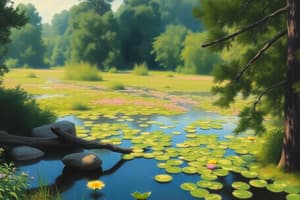Podcast
Questions and Answers
Which of the following is the MOST inclusive level of organization in living systems?
Which of the following is the MOST inclusive level of organization in living systems?
- Biosphere (correct)
- Ecosystem
- Community
- Organism
A plant bending towards sunlight is an example of which characteristic of life?
A plant bending towards sunlight is an example of which characteristic of life?
- Adaptation
- Metabolism
- Response to Stimuli (correct)
- Growth
Which of the following processes involves breaking down complex molecules to release energy?
Which of the following processes involves breaking down complex molecules to release energy?
- Digestion
- Anabolism
- Catabolism (correct)
- Photosynthesis
Which of the following is an example of adaptation in desert plants?
Which of the following is an example of adaptation in desert plants?
Which of the following is an example of asexual reproduction?
Which of the following is an example of asexual reproduction?
Which of these is an example of evolutionary change?
Which of these is an example of evolutionary change?
Which of the following describes the role of decomposers in an ecosystem?
Which of the following describes the role of decomposers in an ecosystem?
Which abiotic factor is essential for the process of photosynthesis?
Which abiotic factor is essential for the process of photosynthesis?
Which of life's characteristics helps organisms maintain internal stability despite external changes?
Which of life's characteristics helps organisms maintain internal stability despite external changes?
Which of the following shows the correct order of increasing complexity in the hierarchy of biological organization?
Which of the following shows the correct order of increasing complexity in the hierarchy of biological organization?
Flashcards
Ecosystem
Ecosystem
A community of living organisms interacting with the nonliving components of their environment.
Organization (Life)
Organization (Life)
Living things are highly organized, with cells as the basic unit of life.
Metabolism
Metabolism
Living organisms carry out chemical reactions to obtain and use energy.
Growth
Growth
Signup and view all the flashcards
Evolutionary Change
Evolutionary Change
Signup and view all the flashcards
Response to Stimuli
Response to Stimuli
Signup and view all the flashcards
Reproduction
Reproduction
Signup and view all the flashcards
Biotic Factors
Biotic Factors
Signup and view all the flashcards
Abiotic Factors
Abiotic Factors
Signup and view all the flashcards
Photosynthesis
Photosynthesis
Signup and view all the flashcards
Study Notes
- An ecosystem consists of a community of living (biotic) organisms interacting with the nonliving (abiotic) components of their environment.
- Nutrient cycles and energy flows link these biotic and abiotic components.
Characteristics of Life
- Living things exhibit a high degree of organization, with the cell being the fundamental unit.
- All organisms consist of one or more cells, the building blocks containing DNA that directs activities.
- Life is hierarchically organized, increasing in complexity from the cell level.
- Cells: The basic unit.
- Tissues: Similar cells performing a function (e.g., muscle, nervous tissue).
- Organs: Different tissues with a specific function (e.g., heart, lungs).
- Organ Systems: Organs working together (e.g., circulatory, digestive).
- Organisms: Complete living beings.
- Populations: Same species in the same area.
- Communities: Different populations in an area.
- Ecosystems: Communities interacting with their physical environment.
- Biosphere: The sum of all ecosystems.
- Metabolism involves chemical reactions for energy usage.
- Energy is essential for life and is obtained through metabolic processes.
- Catabolism breaks down food molecules to release energy.
- Anabolism builds complex molecules for growth and repair.
- Photosynthesis converts carbon dioxide and water into glucose and oxygen using sunlight.
- Cellular respiration breaks down glucose with oxygen to release energy (ATP).
- Digestion breaks down food into smaller absorbable molecules.
- Growth is defined as the increase in size and complexity of living things.
- Growth occurs through cell production and increase in size, be it simple or complex.
- Seedlings develop roots, stems, and leaves when growing into mature plants.
- Caterpillars undergo metamorphosis and develop into butterflies.
- Adaptation occurs as living things evolve to better suit their environment.
- Evolutionary change allows living entities to better suit their environment over time.
- Genetic changes in a population give rise to better adaptation and reproduction in their specific environment.
- Desert plants have adaptations like waxy coatings and deep roots to conserve water.
- Polar bears have blubber for insulation and white fur for camouflage.
- Stimuli provokes reactions from living things in response to changes in environment.
- Living organisms are sensitive to environmental changes
- Homeostasis (internal stability) is maintained despite external changes.
- Plants grow towards sunlight to maximize photosynthesis.
- Animals flee or hide to avoid predators.
- Reproduction allows living beings to create new individuals of their kind.
- Genetic information transmits from parent to offspring.
- Sexual reproduction combines genetic material from two parents (e.g., humans, flowering plants).
- Asexual reproduction involves a single parent and yields identical offspring (e.g., bacteria, some plants).
Components of an Ecosystem
- Biotic factors are the living components.
- Producers (plants, algae, bacteria) produce food through photosynthesis.
- Consumers (animals) obtain energy through consuming others.
- Decomposers (fungi and bacteria) break down dead organisms, returning nutrients to the soil.
- Abiotic factors are the nonliving components.
- Sunlight is the energy source for producers.
- Water is essential for all living things.
- Temperature influences the rate of chemical reactions in organisms.
- Soil provides nutrients and support for plants.
- Air provides oxygen for respiration and carbon dioxide for photosynthesis.
Studying That Suits You
Use AI to generate personalized quizzes and flashcards to suit your learning preferences.




